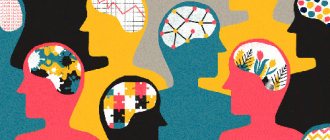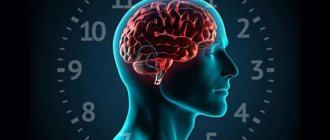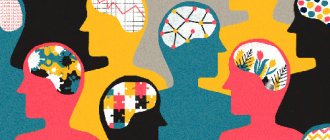Doctors call obsessive-compulsive personality disorder a mental health disorder characterized by a high level of anxiety in the patient. Obsessive (obsessive) ideas are constantly repeated, cause disturbing emotions (disgust or anxiety), a person is not able to control them. Many people suffering from obsessive-compulsive disorder realize that the images or thoughts are a product of their mind, they are unreasonable or excessive. However, obsessions are not resolved through reasoning or logical thinking.
The Yusupov Hospital has created comfortable conditions for the treatment of patients suffering from obsessive-compulsive disorder.
Causes
To date, scientists have not established the exact cause of obsessive-compulsive disorder.
As the results of numerous studies show, obsessive-compulsive disorder is a consequence of disruption of connections between the frontal lobe and deeper structures of the brain (thalamus and basal ganglia). The impulse is transmitted using the neurotransmitter (hormone) serotonin. The disease occurs in several family members, suggesting the role of genes in the development of the disease. Researchers have not identified the exact factors stimulating the onset of the disease.
Scientists have developed 2 theoretical models of the development of obsessive-compulsive disorder: the theory of information integration and neuroanatomical hypotheses. They are not supported by the results of applied research, so it is incorrect to single out any model. Since treatment of an unknown cause of the disease is impractical and ineffective, psychotherapists at the Yusupov Hospital focus, first of all, on eliminating the manifestations of the disease that worsen the quality of life of patients.
Make an appointment
Symptoms
Signs of obsessive-compulsive disorder differ little between children and adults. Patients may experience obsessive ideas:
1.Pollution:
- body fluids (urine, feces),
- microorganisms, pathogens of infectious diseases (herpes, HIV-AIDS);
- environmental objects (radiation, asbestos),
- household chemicals (cleaning agents, solvents);
2. Loss of control:
- fear of acting impulsively so as not to harm yourself or other people,
- fear of terrifying or violent images in the mind;
- fear of saying something offensive or obscene;
- fear of having things stolen;
3. Harm:
- fear of being responsible for something terrible (burglary, fire);
- fear of causing harm to others due to carelessness (dropping something on the ground that could cause injury to another person);
4. Obsessions that are associated with perfectionism:
- excessive concern for accuracy or evenness;
- anxiety associated with the need to remember or know everything;
- fear of forgetting or losing important information when throwing something away;
- fear of losing things;
- inability to decide what to do: keep or throw away an item.
Patients may experience perverted or forbidden sexual images, thoughts, impulses, obsessions about homosexuality or incest, or involvement of children in sexual relations. People with obsessive-compulsive disorder may be obsessed with aggressive sexual behavior towards other people. They develop obsessive religious ideas: preoccupation with blasphemy or insulting God, excessive concern for morality, right or wrong behavior. Other obsessions include superstitious ideas about unlucky or lucky numbers, colors, and worries about physical injury.
Compulsivity is a repetitive mental action or behavior that occurs in response to some stimulus. The compulsion can be overt or observable by others, such as checking that the gas stove is turned off, or a covert mental act that cannot be observed - repeating a certain phrase in the mind. It is more difficult for patients to resist and control hidden compulsions than overt ones. In severe cases of the disorder, the patient repeats rituals constantly throughout the day, which prevents him from performing daily work. Compulsion in itself does not bring pleasure. This distinguishes it from impulsive actions - shopping, gambling, which are associated with immediate gratification. The term ritual is synonymous with compulsion, but it usually refers to behavior that can be seen by other people.
Signs of compulsivity in obsessual-compulsive disorder may include the following:
- cleaning and maintaining cleanliness;
- Washing your hands too often in a certain way;
- excessive amounts of bathing, showering, hygiene procedures, body and oral care;
- Constant cleaning of household items.
Patients can check that they are not harming themselves or others, check that something terrible has happened, and check that they are not making mistakes. Are some parts of their body still in place? They are characterized by repeating routine actions, rewriting or reading the same text over and over, repeating the same action (performing a task three times, since three is a “safe” number).
Mental compulsions consist of thinking about events to prevent harm to oneself and others, some terrible events, counting up to a “good” number when performing tasks. Physical signs of obsessive-compulsive disorder include the following symptoms:
- dizziness;
- headache;
- pain in the epigastric region;
- muscle tension;
- increased heart rate,
- shallow breathing;
- derealization (feeling disconnected from the body).
People suffering from obsessive-compulsive disorder have an impaired quality of life. They suffer from obsessive thoughts, which, when they arise, cause severe anxiety, which requires the performance of certain rituals to get rid of it. Manifestations of obsessive-compulsive disorder interfere with the patient’s relationship with other people.
Obsessive-compulsive disorder is a mental health disorder. It must be diagnosed and treated by a psychiatrist or psychotherapist. There are some signs that you should contact a specialist if present:
- uncertainty in one’s actions (“trading” with oneself - the need to search for symptoms of a non-existent pathology, additionally check the gas stove, etc.);
- feeling of an obsessive need to perform certain rituals: washing hands according to a certain algorithm, closing doors or windows;
- the inability to be convinced of the groundlessness of one’s own fears, which causes a state of anxiety.
Most patients have a clear understanding of the onset of signs of a mental disorder. Patients have a constant overwhelming feeling of anxiety, which has certain grounds. This makes it difficult to live a normal life.
Obsessive-compulsive disorder (OCD)
Among all anxiety conditions, compulsive-obsessive disorder or neurosis is the most complex. Statistics show that only 2-3% of people worldwide suffer from it. Such data suggests that very few people talk about the existing problem with loved ones or seek qualified medical help from a psychologist or psychotherapist. As a rule, symptoms of compulsive-obsessive disorder appear between the ages of 25 and 25, and OCD also occurs in childhood and adolescence.
What you need to know about OCD?
Obsessive-compulsive disorder, according to ICD 10, is obsessive thoughts or forced actions that are repeated. The first are manifested by images, ideas, motivations, which, like stereotypes, arise in a person’s head. Often they upset, so a person strives to resist them, but cannot fight them. At the same time, he himself does not realize that thoughts are involuntary and disgusting.
Obsessive behaviors are stereotypical behaviors that are constantly repeated by a person. He does not experience pleasure from them and cannot perform useful actions. He tries to do something that, in his opinion, will help avoid negative events that are about to happen. And repetition of actions occurs because a person does not see the meaning and effectiveness in them.
With OCD, the patient is constantly in an anxious state, and when compulsive actions are suppressed, it only intensifies.
Manifestations of OCD
Obsessive-compulsive personality disorder has corresponding symptoms. Thus, patients complain that their thoughts, images, desires are repeated, and it is impossible to get rid of them. The person himself understands that they are unwanted, so he is worried and afraid.
Trying to ignore desires, images, thoughts, a person resorts to other actions, thoughts, rituals, which brings relief for a while, but cannot completely solve the existing problem.
Examples of obsessive thoughts:
- a feeling of fear that the windows, doors or faucets in the bathroom have been left open;
- fear of getting dirty when in contact with certain objects or people;
- when a person leaves home, he worries that he left the plumbing fixtures, iron, stove on;
- obsessive desire to disseminate information that could harm the patient or his environment;
- desire to remove or arrange things correctly, etc.
Compulsions are actions and thoughts that have a clear sequence and are constantly repeated. To relieve anxiety and get rid of stress, a person uses mental acts or obsessive actions. The manifestation of compulsions occurs after the following actions:
- constant checking of locks, switches, equipment;
- frequent hand washing or use of special cleansing products;
- avoiding contact with people, objects, animals that could be a source of infection (in his opinion);
- constant repetition of prayers, mental rituals, trying to prevent unwanted consequences;
- refusal to go to places and events, fearing a catastrophe (the patient may refuse to drive a car, stand on the edge of a platform, go out onto a balcony, etc.).
For a long time, a person may not notice the symptoms of obsessive-compulsive disorder. Therefore, if loved ones notice at least one of the symptoms of the disease, you need to immediately consult a psychotherapist and convince your loved one of the need for medical help.
The causes of compulsive obsessive disorder OCD (obsessive-compulsive disorder) can occur due to various factors. It is often detected due to a genetic predisposition, as well as in people who often doubt, try to constantly check the information they receive.
Examples of compulsive-obsessive disorder: if, in the process of raising a child, parents set strict boundaries and prohibitions, this can lead to the development of OCD in various forms. If stressful situations arise against the background of fear, the pathology will only develop. OCD can also occur in people who frequently experience nervous shock.
Diagnostic methods
A specialist can make a diagnosis of OCD based on the following criteria:
- obsessive thoughts and actions;
- symptoms are observed at least half the time in two weeks;
- obsessions or compulsions are sources of distress;
- it must be unpleasant for the person to think about performing the action;
- unpleasantly repetitive thoughts, desires, impulses;
It is not necessary that compulsive actions respond to specific thoughts or fears; a person uses them in order to get rid of spontaneous anxieties, tension, and discomfort inside.
Thus, in order to make a diagnosis of “obsessive thoughts and ruminations,” the patient must have designated thoughts, they must be in the form of ideas, images of a mental nature, impulses to perform actions that are unpleasant for a particular subject in almost all cases. If the patient is dominated by compulsions based on fears, he tries to prevent danger (can take up to several hours a day) by performing a compulsive action, a diagnosis of “compulsive actions” is made. If the symptoms of obsession and compulsion are equally severe, a mixed form of OCD is diagnosed.
To make a diagnosis, the doctor interviews the patient and examines him. To date, there are no laboratory tests that can show OCD. The diagnosis uses the Yale-Brown scale, which can be used to identify the severity of symptoms, regardless of the form of obsessive thoughts or actions.
Treatment methods
Today, obsessive-compulsive disorder is treated using the following methods:
Medication. In most cases, if OCD is diagnosed, antidepressant medications are prescribed. At the initial diagnosis, antidepressants are prescribed. If therapy is ineffective, the doctor will select drugs from other groups and will monitor the progress of treatment, which is usually carried out on an outpatient basis. Only in difficult cases is a stay in a medical facility indicated.
Psychotherapeutic. Cognitive-behavioral treatment in various forms has proven highly effective. For mild obsessive-compulsive disorder, this treatment is more effective than drug therapy. In addition, psychotherapy can be used in combination with medications, especially if disorders are difficult to treat. During the treatment of OCD, individual methods, family methods, and group work are used. It will be long-term, taking at least a year. However, treatment should not be stopped, despite the fact that the first results will be achieved after 8-12 weeks, and sometimes earlier.
When treating patients of childhood and adolescence, the same algorithms are used as for adults. In most cases, psychosocial methods, psychotherapy, and family psychological education are used. Exposure and response prevention are part of cognitive behavioral therapy. During the latter method, the patient purposefully and consistently comes into contact with stimuli that he avoids, and the occurrence of pathological reactions is deliberately slowed down.
Treatment is also aimed at preventing complications of obsessive-compulsive disorder in which other mental disorders are associated. For example, if obsessions are not corrected for a long time, anxiety, suicidal thoughts, and severe depression may occur. This is explained by the impossibility of getting rid of OCD.
Obsessive-compulsive disorder, if left untreated, becomes chronic. However, for many people with this diagnosis, the condition can be stable for a long time, especially if there is only one obsession.
There is no specific prevention for OCD, because all the factors that can cause such disorders have not been reliably established. Therefore, in order to avoid their development, measures are recommended that help prevent the development of symptoms, for which it is necessary to exclude factors that traumatize the psyche in the family and at work, and be attentive to the upbringing of the child.
Examples
Life for those suffering from OCD is quite difficult. They suffer from obsessive thoughts, the occurrence of which is accompanied by severe anxiety, which requires the performance of certain rituals to get rid of it, which is typical for patients diagnosed with obsessive-compulsive disorder. Psychology classifies OCD as an anxiety disorder.
Manifestations of obsessive-compulsive disorder interfere with a person’s normal functioning and the building of his relationships with others.
The development of OCD does not cause any specific fear. Some obsessive disorders are very well known. For example, the need to constantly wash your hands or check the working stove is familiar to many. Obsessive-compulsive mental disorder can manifest itself as pathological hoarding, hypochondria, and fear of harming others. OCD often manifests itself as paralyzing fear associated with sexual orientation.
It is necessary to understand that OCD is a mental disorder, therefore it can only be identified with the help of a professional doctor - a psychotherapist, a psychiatrist. However, there are certain symptoms that, according to experts, may indicate the presence of obsessive-compulsive disorder:
- “trading” with oneself – uncertainty in one’s actions: the need to additionally check the stove, search for symptoms of non-existent diseases;
- feeling of an obsessive need to perform certain rituals: closing doors, washing hands, etc.;
- the inability to convince oneself of the groundlessness of one’s own fears, which causes a state of anxiety;
- a clear understanding of the onset of symptoms of a mental disorder is typical for most patients;
- a constant, overwhelming feeling of anxiety that has certain grounds, which interferes with normal functioning.
Therapy
Treatment of obsessive disorders involves two approaches. First of all, psychotherapists at the Yusupov Hospital Psychiatry Clinic focus their efforts on eliminating compulsive actions. In addition, measures are taken to relieve the patient of obsessive thoughts.
Compulsive-dominant OCD is treated using the exposure method. The essence of this method is the patient’s conscious strengthening of his obsessive reactions, which are brought to the point of absurdity. In this way, it brings irrational anxiety closer, resulting in a decrease in its intensity. This gives the psychotherapist the opportunity to more easily influence the initial component of obsessive-compulsive disorder, obsessive thoughts and impulses.
The use of the exposure method is not justified in all cases, since it is ineffective to treat obsessive-compulsive disorder in patients with OCD, in which compulsions are practically absent, and the leading role is played by obsessive ideas, images and fears. In such cases, therapy is focused on how the patient’s emotional and logical connections interact and their separation from each other. This is a more serious problem, since this type of obsessive-compulsive disorder is much more difficult to cure. The task of the psychotherapist in such cases is to change the established way of thinking and the relationship between the logic of thinking and its emotional content.
Most often, patients with obsessive-compulsive disorder have a high intellectual level and intact logic. The insidiousness of OCD is that patients operate with obvious logic, neglecting the emotional component of the disorder. Patients do not notice that their cause-and-effect relationships, which are formed at the level of their emotional and logical connections, are gradually changing. Therefore, their own doubts and fears seem groundless to them, but a strong-willed effort to overcome them is not enough for them.
Obsessive-compulsive disorder (OCD). Illness or “habit of repetition”?
Pashnik Anna Iosifovna, psychotherapist, healthcare institution “City Clinical Psychiatric Dispensary”
The name of the disease comes from two English words: obsessio and compulsio. The former means “obsession with an idea,” while the latter can be interpreted as “compulsion.”
People suffering from OCD are considered disabled in some countries. Most of them spend a lot of time mindlessly due to compulsions. Obsessions are often expressed by obsessive thoughts and phobias, which also negatively affects the patient’s quality of life.
How does the disease begin?.
According to medical statistics, obsessive-compulsive disorder develops between 10 and 30 years. Regardless of when exactly its first symptoms appeared, patients turn to the doctor between 27 and 35 years of age. This means that several years pass from the development of the disease to the start of treatment. Obsessive-compulsive personality disorder affects one in three adults. There are far fewer small children among the patients. This diagnosis is confirmed in every second child out of 500.
At the initial stage, the symptoms of the disease manifest themselves in the form of obsessive states (actions) and various phobias (obsessive thoughts). During this period, a person may still be aware of their irrationality. He is visited by unpleasant or frightening thoughts, but while most can easily brush them aside, for some this is impossible. People with OCD think about why they have a thought like this, returning to it again and again. They can only get rid of it by performing certain actions.
Obsessions are frightening thoughts, images or impulses that do not leave a person. Compulsions are certain actions that help temporarily eliminate obsessive thoughts and reduce anxiety. The condition can progress, causing the person to have more and more compulsions, and be chronic or episodic.
Over time, in the absence of medication and psychological help, the disorder worsens. The patient loses the ability to adequately evaluate his fears. In advanced cases, treatment involves hospitalization with the use of serious medications.
Frequent intrusive thoughts.
The most common obsessions and corresponding compulsions:
— Fear of contracting a disease or fear of germs. In order to prevent this, a person tries to wash his hands or take a shower as often as possible, wash his clothes, and thoroughly wash all surfaces with which he comes into contact. This can take many hours every day.
-Fear of harming yourself or your loved ones. The patient tries not to be alone or with the person he believes could cause harm. Hides potentially dangerous things, such as knives, ropes, heavy objects.
— Fear that the necessary thing will not be available. A person repeatedly checks his pockets and bags to see if he forgot to put documents, essential items or medicines.
-Order and symmetry. It must be in a room where everything is in its place and subject to certain rules. They are very careful to ensure that even small objects are placed in a certain order, for example, arranged in height or symmetrically. And if someone touches or places a folder on the table incorrectly, the person experiences emotional stress.
-Superstitions. A person may fear that he will have bad luck if he does not perform a certain ritual. Thus, an OCD patient, leaving the house, had to put on “lucky” shoes, look in the mirror twice and stick out his tongue at himself, and pull the door handle seventeen times. If something unpleasant happened to him, he increased the number of actions.
— Thoughts that are prohibited by religion or morality. In order to drive away images or inappropriate thoughts, a person can read a prayer or take donations to the church, giving the last.
— Thoughts of a sexual nature with elements of cruelty. A person tries to avoid intimacy out of fear of committing an unacceptable act towards a partner.
Clinical manifestations of OCD.
Compulsive-obsessive disorder has characteristic symptoms:
-thoughts should be perceived as your own, and not as a voice from above or another person;
-the patient resists these thoughts and tries unsuccessfully to switch to others.
-the thought that what is presented can happen frightens a person, makes him feel shame and guilt, causes tension and loss of activity;
-obsession is often repeated.
Main reasons.
Scientists still cannot list the main factors contributing to the occurrence of mental illness. However, there are a large number of theories. According to one of them, among the biological factors, obsessive-compulsive disorder has the following causes: metabolic disorders; head injuries and injuries; hereditary predisposition; complicated course of infectious diseases; deviations at the level of the autonomic nervous system. Doctors propose to include social causes of the disorder in a separate group. Among them, the most common are the following: upbringing in a strict religious family; difficult relationships at work; frequent stress. The panic fear inherent in this mental illness may be based on personal experience or imposed by society. A striking example of the consequences of such a disorder is viewing crime news. A person tries to overcome emerging fears with actions that convince them of the opposite. He can double-check a locked machine or count banknotes several times. Such actions bring only short-term relief. It is unlikely that you will be able to get rid of obsessive ideas on your own. In this case, the help of a specialist is required. Otherwise, the disease will completely consume the human psyche.
Psychologists say that people who have developed obsessive-compulsive personality disorder have some thinking characteristics:
— They are confident that they can control everything, even their own thoughts. If a thought appeared, it means that it was in the subconscious and the brain had been thinking about it for a long time, and, accordingly, it is part of the personality.
- Hyperresponsibility. A person is responsible not only for actions, but also for thoughts.
-Belief in the materiality of thought. If a person imagines something terrible, then it will happen. He believes that he is capable of causing trouble.
— Perfectionism. A person has no right to make a mistake. He must be perfect.
Compulsive personality disorder most often occurs in a person who was brought up in a family where parents controlled all areas of the child’s life, making excessive demands and demanding ideal behavior from him. In the presence of the two components listed above, the impetus for the manifestation of the disorder can be a stressful situation, overwork, overexertion or abuse of psychotropic substances. Stress can be caused by moving, changing jobs, threats to life and health, divorce, or the death of a loved one.
The OCD cycle.
The actions of a person with obsessive-compulsive disorder are cyclical.
1. First, a certain thought arises that frightens and makes you feel shame and guilt for it.
2. Then concentration occurs on this thought against desire. The result is mental tension and increasing anxiety.
3. The human psyche finds a way to calm down by performing stereotypical actions that he thinks will save him. Thus, short-term relief occurs.
4. But the feeling of his abnormality due to the thought that has arisen does not leave him and he returns to it again. The cycle takes on a new turn.
What influences the development of neurosis.
The more often the patient resorts to ritual actions, the more dependent he becomes on them. It's like a drug. Disorders are reinforced by avoidance of situations or actions that cause obsessions. A person, trying not to face a potentially dangerous situation, still thinks about it and becomes convinced of his abnormality. The situation can be aggravated by the behavior of loved ones who call the person suffering from the disorder crazy or forbid them to perform the ritual. After all, if he is crazy, then he really can carry out the actions that he is so afraid of. And imposing a ban on compulsions leads to an increase in anxiety. But the opposite situation also happens, when relatives are involved in the performance of the ritual, thereby confirming its necessity.
Diagnosis and treatment.
The symptoms of obsessive-compulsive disorder are similar to those of schizophrenia. Therefore, a differential diagnosis needs to be made. Especially if the obsessive thoughts are unusual and the compulsions are eccentric. The important thing is whether thoughts are perceived as your own or as imposed. Depression is also often accompanied by OCD. If they are equally strong, then it is recommended that depression be considered primary.
The obsessive compulsive disorder test or Yale-Brown scale is used to determine the severity of the symptoms of the disorder. It consists of two parts of five questions: the first part allows you to understand how often obsessive thoughts appear and whether they can be attributed to OCD; the second part analyzes the impact of compulsions on everyday life.
If obsessive and compulsive disorder is not very pronounced, then a person can try to cope on his own. To do this, you need to learn to switch your attention to other actions. For example, start reading a book. Postpone the ritual for 15 minutes, and gradually increase the delay time and reduce the number of ritual actions. This way you will understand that you can calm down without performing stereotypical actions. If the severity is moderate or higher, you need to seek help from any of the specialists: psychotherapist, psychologist, psychiatrist. If the disorder is severe, the psychiatrist will make a diagnosis and prescribe medication. Medications are prescribed to alleviate the condition - tricyclic antidepressants or selective serotonin reuptake inhibitors. Atypical antipsychotics are also used to control symptoms. They will help you calm down and reduce anxiety. However, drug treatment for compulsive obsessive disorder does not have a permanent effect. After finishing the medication, OCD returns. The most effective way is psychotherapy. With its help, almost 75% of those who seek help recover. A psychotherapist may offer: cognitive behavioral psychotherapy, exposure, hypnosis. Exposure with response prevention techniques are effective for OCD. It lies in the fact that a person, faced with his experiences in a controlled situation, learns to cope with them without the usual reaction of avoidance. So, to treat a person with a fear of germs, they may suggest touching a subway handrail or an elevator button and not washing your hands for as long as possible. The tasks are gradually becoming more complicated and they are asked to reduce the number of actions and the duration of the ritual. Over time, the patient gets used to it and stops being afraid. However, not everyone can handle this technique. More than half of patients refuse it due to strong feelings. Cognitive therapy helps the patient see the irrationality of his fears, dismantle his way of thinking and realize that it is wrong. Teaches effective ways to switch attention and adequately respond to obsessive thoughts without the use of ritual. Family therapy can help the patient. Thanks to it, family members will be able to better understand the causes of the disorder and learn how to behave correctly if obsessions begin. After all, close people can both help cope with the problem and cause harm with their behavior. Group psychotherapy will provide support and approval, and reduce feelings of inferiority. The success of a fellow sufferer is highly motivating. And the person understands that he can cope with the problem.
Contact phone number 245 61 74








